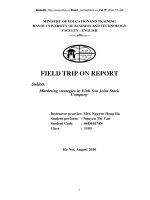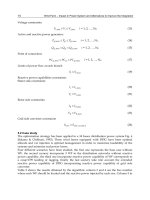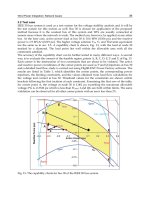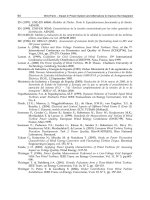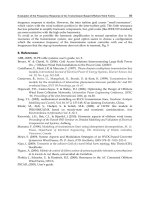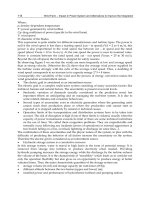Recruitment and selection in saigin shoes joint stock company and recommendations to improve the situation
Bạn đang xem bản rút gọn của tài liệu. Xem và tải ngay bản đầy đủ của tài liệu tại đây (30.84 MB, 74 trang )
I.
I
HO
cm MINH
CITY UNIVERSITY OF FOREIGN LANGUAGES AND
INFORMATION TECHNOLOGY
SCHOOL OF FOREIGN LANGUAGES
GRADUATION PAPER
Theme:
Advisor
: Mr.DANG THANH BINH,M.E.M
Student
: DANG NHU TRANG
Class
: HA0201
Student No.: 0271145
TV 09; HQc Huflil
1111111111111111111111111111
101000662
HO CHI MINH CITY, JULY 2006
RECRUITMENT AND SELECTION IN SAIGON SHOES
JOINT-STOCK COMPANY AND RECOMMENDATIONS TO
IMPROVE THE SITUATION
Acknowledgement
Abstract
Index
Page
INTRODUCTION:
1
CONTENT:
Chapter 1: Literature review
1.1 Overview of human resource management
1.1.1 Human resource management..
3
3
1.1.2 Support activities
a) Human resource planning
4
b) Job analysis
9
1.1.3 The importance of recruitment and selection process
1.2 Recruitment
10
11
1.2.1 Alternatives to recruitment..
11
1.2.2 Internal recruitment
13
a) Internal sources ofrecruitment..
13
b) Internal methods ofrecruitment..
14
1.2.3 External recruitment
16
a) External sources ofrecruitment..
16
b) External methods ofrecruitment..
17
1.3 Selection
18
1.3.1 Environmental factors affecting the selection process .. 19
1.3.2 The selection criteria
20
1.3.3 The selection process
21
Chapter 2: Introduction to the Saigon Shoes Joint-stock Company
2.1 The history of Saigon Shoes Joint-Stock Company
29
2.2 Functions, tasks and objectives of the company
30
2.3 The organizational structure of the company
31
2.4 Future goals and tasks of the company
34
2.5 Business activitives:
2.5.1 Advantages
2.5.2 Disadvantages
34
,
35
Chapter 3: Analyzing the current recruitment and selection processes in
the Saigon Joint-stock Company
3.1 The personnel situation:
3.1.1 The characteristics of the labor force
36
a) The educational level of the labor force
36
b) The age of the labor force
38
c) The sex of the labor force
39
d) The turnover rate of the labor force
40
3.1.2 The selection criteria
41
3.1.3 Employees database keeping procedure
42
3.1.4 Alternatives to recruitment..
42
3.2 The current recruitment process:
3.2.1 Internal recruitment
44
a) Sources
44
b) Methods
45
3.2.2 External recruitment
45
a) Sources
45
b) Methods
46
3.3 The current selection process:
3.3.1 Indirect employees
,
49
3.3.2 Direct employees
51
3 A Some strengths and weaknesses of the current recruitment and selection
process
304.1 Strengths
53
304.2 Weaknesses
55
Chapter 4: Some recommendations
4.1 Human resource planning
59
4.2 The use of internal sources
60
4.3 The use of employment agency
61
404 The use of alternatives to recruitment..
61
4.5 The recruitment process
61
4.6 The selection process
CONCLUSION
REFERENCES
~
62
64
ADVISOR'S COMMENTS
.........................................................................................................
.........................................................................................................
.........................................................................................................
.........................................................................................................
................................................•........................................................
.........................................................................................................
.........................................................................................................
...............................................................................•.........................
.........................................................................................................
.........................................................................................................
.........................................................................................................
.........................................................................................................
.........................................................................................................
.........................................................................................................
.........................................................................................................
.........................................................................................................
.........................................................................................................
.........................................................................................................
.........................................................................................................
.........................................................................................................
.........................................................................................................
.........................................................................................................
.............................................................................•...........................
.........................................................................................................
•.....•....•..••••••.••............••••••...........••••••.•..........••.•••••••.........••••••....•...••
.........................................................................................................
.........................................................................................................
.........................................................................................................
.........................................................................................................
.........................................................................................................
.........................................................................................................
.........................................................................................................
.........................................................................................................
.........................................................................................................
EXAMINER'S COMMENTS
................................................................................•........................
..............................................................................•..........................
.........................................................................................................
...................................................................................•.....................
.........................................................................................................
.........................................................................................................
...........................................................••............................•.••............
.........................................................................................................
....................•....................................................................................
.............................................................................•...........................
.........................................................................................................
.........................................................................................................
.............................................................................•...........................
..............................................................................•..........................
.........................................................................................................
.........................................................................................................
.........................................................................•...............................
.........................................................................................................
.........................................................................................................
.........................................................................................................
...........................................................•.................••..........................
.........................................................................................................
.........................................................................................................
.........................................................................................................
.........................................................................................................
.........................................................................................................
.........................................................................................................
••••.............••••••••••...........••••••............•.•••••••............•••••.•.........••••••••...•
...............................................................................•.........................
.........................................................................................................
......•••..••.................••••••••.•...........••••••..•...•........•••••••••..•........•..••••••....
.••.••............•..••••••••............•••••••..•.........•••••••••••.••..........•....•...............
.........................................................................................................
.........................................................................................................
ACKNOWLEDGEMENTS
In order to complete this graduation paper, I have received
a lot of help
and invaluable advice from many helpful and respectful people.
First of all, I would like to send my special thanks to the School Management
Board and teachers of Ho Chi Minh City University of Foreign Languages and
Information Technology.
Especially, I would like to express my sincere thanks to Mr. Dang Thanh
Binh, M.E.M, my advisor who read through this paper with enthusiatic to give me
support and valuable advice. Without his helpful guidance, this research would not
be finished.
I am very grateful to Department
of Personnel
and Administration
of
Saigon Shoes Joint-stock Company, who helped me in exchanging information
and experience, in contributing opinions and supplying relative materials.
Last but not least, I truly express my gratitude to my family and my friends
for their support and encouragement.
July 14,2006
Dang Nhu Trang
ABSTRACT
"Recruitment and selection in Saigon Shoes Joint-Stock Company and
recommendations to improve the situation" is the subject of my graduation
paper through the internship period at Department
of Personnel
and
Administration of Saigon Shoes Joint-stock Company.
This study was conducted on theory and praticality of the observations
and interviews with Saigon Shoes Joint-stock Company personnel managers
to analyze the recruitment and selection processes
of the Company. The
findings showed that Saigon Shoes Joint-stock Company's recruitment and
selection processes had been doing their tasks well. However, it also had a
number of weaknesses. Thus, some recommendations
were given to the
recruitment and selection activitives so that it could meet the requirements
of current human resource management.
INDEX
Figure 1:
The human resource planning process
8
Figure 2:
The recruitment process
12
Figure 3:
The selection process
22
Figure 4:
The sex of the labor force in SSJ Company
39
Figure 5:
The chart ofIncreasing and Decreasing of employees
40
Figure 6:
A summary of the recruiting process
62
Table 1:
Education level of the labor force in SJJ Company
36
Table 2:
Age of the labor force in SSJ Company
38
Table 3:
Increasing and Decreasing of employees
: 40
Diagram 1: Indirect selection process in SSJ Company
49
Diagram 2: Direct selection process in SSJ Company
51
Graduation
Advisor:
paper
DANG THANH BINH, M.E.M
INTRODUCTION
In recent years, together with the rapid economic growth and pressure of the
global competition, the key task of all companies all over the world is try to
maximize business's products and services supply to their customers effectively.In
Vietnam, with the investment of many foreign enterprises, the competition is more
and more severe. Besides, identifYing challenges and planning a long-term strategy
for human resource are essential if businesses try to expand their scale and increase
their competitiveness.
Therefore,
an enterprise
focuses not only on finance,
marketing, administrative management but also on human resource management
because "Career is successful or fail due to men" (Konosuke, 1997).
Human resource management includes recruitment and selection, training
and development, performance appraisal. ... Nevertheless, recruitment and selection
processes are important tasks because when recruitment and selection are well done,
an enterprise can attract qualified job applicants to increase the organization's
effectiveness.
Therefore,
this research analyzes the recruitment
and selection
processes in the Saigon Shoes Joint-stock Company. This company is an enterprise
who produces and outsources cloth shoes and bags for many foreign countries, so
the Company always needs a large number of employees. However, the company is
usually in short of workforce and the recruitment and selection processes have to be
carried out regularly. Therefore, having an effective human resource management is
an important factor in order to help the company achieve its goals.
This research aims at analyzing the recruitment and selection activities to
improve human resource management
in Saigon Shoes Joint-stock
Company.
Moreover, after analyzing the current recruitment and selection process in the
Saigon Shoes Joint-stock
Company,
this research will help human resource
managers recognize that employees are important resources. Therefore, human
resource management must have a strategic visibility and must be considered as the
most important task.
Student:
DANG NHU TRANG
Page 1
Graduation
paper
Advisor:
DANG
THANH BINH, M.E.M
However, because of the limitation of time, knowledge and experience, the
research only focuses on the recruitment and selection activities of the Saigon Shoes
Joint-stock Company, draws out the strengths and weaknesses of those activities, so
that some measures are suggested for more effective management.
The organization of this study consists of four chapters. Chapter one is the
literature review of the human resource management, especially the recruitment and
selection process. An overview of the Saigon Shoes Joint-stock
Company is
introduced in the chapter two. Chapter three analyzes the current recruitment and
selection process in the Saigon Shoes Joint-stock Company and some strengths and
weaknesses
of these activities. Some recommendations
to improve the human
resource management in the company are discussed in the final chapter.
Student:
DANG NHU TRANG
Page 2
Graduation
paper
Advisor:
DANG THANH BINH, M.E.M
CHAPTER 1
LITERA TURE REVIEW
1.1 OVERVIEW OF HUMAN RESOURCE MANAGEMENT
1.1.1 Human resource management:
Recently, many companies recognize the growmg importance
of their
human resource because although the human resource management does not control
many of the factors that shape the employee's contribution, such as the capital,
materials, and procedures, it is responsible for managing people in such a way that
these factors are most productively used (William B.Werther.et ai, 1993)
An important element that causes most of ineffective business cases is the
lacking of quality and strength of management skills. That is, managers may not
know how to make full use of human resource and there is a waste of human and
material resources. Therefore, in order to be effective, managers must understand
and competently practice human resource management.
"Human Resource Management is the recognition of the importance of an
organization's workforce as vital human resources contributing to the goals of the
organization, and the utilization of several functions and activities to ensure that
they are used effectively
and fairly for the benefits
of the individual,
the
organization, and society."(Schuler.et al,2000)
1.1.2 Support activities:
Before conducting the recruitment and selection process, effective managers
have to consider some supporting activities such as human resource planning and
job analysis, which provide necessary information about job requirements
and
employee qualification
Student:
DANG NHU TRANG
Page 3
Graduation
paper
Advisor:
DANG THANH BINH, M.E.M
a. Human resource planning:
"Human resource planning is the process of systematically reviewing human
resource requirements
to ensure that the required number of employees, with
required skills, is available when needed."(Wayne.et al,2001).
The purpose of human resource planning is helping the company to choose
the right person in the right position. If a human resource planning is well done, a
company can choose appropriate employees who have required skills to accomplish
organizational objectives. Moreover, effective human resource planning can be a
contribution for the success of other human resource activities such as recruitment,
selection, training and development.
There are six steps in human resource planning as follow: (Nguyen,2000)
Step 1: Environmental
scanning
Human resource planners can identity and anticipate source of threats and
opportunities
and drive the organization's
strategic planning by environmental
scanning. It helps the human resource planners have a better understanding of the
context in which human resource decisions are or will be made. Both external and
internal factors are critical for effective planning.(Nguyen,2000)
External factors:( Harris, 2000)
•
Globalization:
Globalization
is a fact of business today. There are both positive and
negative sides to globalization. On the positive side, greater globalization creates
more potential markets for businesses which bring to the company profits and
opportunities to consolidate their positions in the market places. On the negative
side,
greater
globalization
creates
more
competition.
In order to survive,
organizations must compete against businesses around them, and even around the
world.
•
Economic:
It is difficult for personnel specialists to predict the developments in the
organization's
Student:
environment in the short run or long run. Economic developments
DANG NHU TRANG
Page 4
Graduation
have
paper
a noticeable
Advisor:
effect
but are difficult
DANG
to estimate
THANH BINH, M.E.M
such
as inflation,
unemployment, interest rates ...
•
Legal:
These factors are easier to predict, but their implications are seldom clear.
Laws
and government
regulations
have many
effects
on human
resource
management. They are issued to protect employees' rights discrimination, working
conditions ... It is necessary to conduct analysis on laws to ensure the success of
human resource planning.
Internal factors:
•
Business strategy:
The approach that a company take in conducting its business is referred to as
its business strategy.(Harris,2000)
Each business strategy has implications for human resource practices. Man
IS
an essential resource for organizational
strategy accomplishment.
Therefore,
human resource planners should analyze the company's business strategy to identifY
the most appropriate employees for the purpose of fulfilling the organization's goals
and missions.
•
Organizational structure:
Organizational structure refers to how work tasks are assigned, who reports
to whom, and how decisions are made (Harris, 2000). Therefore, company should
complete the analysis of organizational
structure in order to choose suitable
employees for the organization's success.
Step 2: Labor demand forecast
Labor demand forecast is an estimate of what the organization's
human
resource needs will be in the future. This includes the number of employees that
will be needed, the types of skills that will be required in order to realize the stated
goals. Before human resource requirements can be projected, demand for the finn's
Student:
DANG NHU TRANG
Page 5
Graduation
paper
Advisor:
DANG
THANH
BINH, M.E.M
goods or services must first be forecasted. This forecast is then converted into
people requirements for the activities necessary to meet the demand. (Nguyen,2000)
Step 3: Labor supply forecast
When the company identified the labor demand forecast, the next thing
which they must do is to determine whether the firm will be able to secure
employees
with the necessary
skills, and from what sources,
availability
forecast. It helps the managers to determine whether the needed
employees
may be obtained
from within
the company,
is called an
from outside
the
organization or from both of the two sources. There are two sources of supply:
internal and external supply. (Nguyen,2000)
•
Internal supply: consists of those workers presently work for the firm. They
can be promoted, transferred or demoted to fill desired job vacancies.
Managers should consider either management inventories, which contains
detailed information about each manager and is used to identifY individuals
to move into higher level positions to look for the appropriate candidates for
the firm.
External
supply: consists of those individuals in the labor forces who are
potential recruits of the firm (including those working in another firm). The skill
levels being sought determine the relevant labor market. The entire country (or
world) may be the relevant labor market for highly-skilled job whereas for simple
jobs, the relevant labor market is usually the local community. Determining the
relevant labor market will also decide what type of recruiting approach should be
used. (Nguyen,2000)
Step 4: Gap analysis
Gap analysis is used for reconciling the forecasts of labor demand and
supply. At least, this process identifies potential shortages or surplus of employees,
Student:
DANG NHU TRANG
Page 6
Graduation
paper
Advisor:
DANG THANH BINH, M.E.M
skills and jobs. In addition, however, planners can compare several environmental
forecasts with alternative supply and demand forecasts to determine the firm's
readiness for different business scenarios. From a problem- solving perspective, gap
analysis is used to pair up potential strengths and opportunities with solutions in
order to evaluate how the firm might attack the future. This decision-making
process
involves
(1) a search for alternative
solution,
(2) an evaluation
of
alternatives, and (3) a choice of solutions. (Nguyen,2000)
Step 5: Action programming
Action programming is the step of human resource planning that lays out the
events that need to be executed to realize the human resource plan. It makes certain
that the decisions on environmental scanning and labor forecast (in the previous
four steps) turn to reality. (Nguyen,2000)
Step 6: Control and evaluation
Control and evaluation monitor the effectiveness of human resource plans
over time. Deviation from the plan is identified and actions are taken. Obviously,
actual staffing levels compared to projected levels should be evaluated for accuracy.
Conducting evaluations also makes it easier to determine whether long-run planning
objective will be met. (Nguyen,2000)
Student:
DANG NHU TRANG
Page 7
Graduation
paper
Advisor:
DANG THANH BINH, M.E.M
EXTERNAL ENVIRONMENT
INTERNAL ENVIRONMENT
Strategic Planning
Human Resource Planning
Forecasting
Human
Resource
Reauirements
Demand
Comparing
Requirements
and Availability
Forecasting
Human Resource
Availability
Surplus of Workers
=
Shortage of
Workers
Supply
No Action
Restricted Hiring,
Reduced Hours, Early
Retirement, Layoffs,
Downsizing
Selection
Figure I: The Human Resource Planning Process
Source: Mondy, Noe, and Premeaux, 2001, Human Resource Management
Student:
DANG NHU TRANG
Page 8
Graduation
bJo
paper
Advisor:
DANG THANH BINH, M.E.M
b analysis:
Job analysis is a systematic process of gathering information about a job. It
determined the job's duties and responsibilities, skills and knowledge required for
performing the job, relationship to other jobs and working conditions under which it
is performed. (Wayne .et aI, 2001)
Job analysis is performed
•
on three occasions:
First, it is done when the organization is founded and a job analysis program
initiated for the first time.
•
Second, it is performed when new jobs are created.
•
Third, it is used when jobs are changed significantly as a result of new
technology, methods, procedures, or system. The majority of job analyses are
performed because changes in the nature ofjobs.( Wayne.et al,2001)
Job analysis
information
is used to prepare
both job
description
and job
specification.
Job description
Job description is a document that provides information regarding the tasks,
duties, and responsibilities of the job. Job description should be both relevant and
accurate. They should provide concise statements of what employees are expected
to do on the job and indicate exactly what employees should follow, how they do it,
and the conditions under which the duties are perfonned. (Wayne.et al,2001)
Job specification
Job specification
qualifications
IS a document
containing
the mInImum
acceptable
that a person should possess to perform a particular job. Items
typically included in the job specification are educational requirements, experiences,
personality
traits, and physical
together with job description,
Student:
DANG NHU TRANG
abilities (Wayne.et
al,200 1). This document,
ensures the organization
to avoid either over-
Page 9
Graduation
paper
Advisor:
DANG THANH BINH, M.E.M
recruitment or under-recruitment. That means the organization can select the most
appropriate employees through the effective tool of recruitment - the job analysis.
When human resource planning involves adding to the labor force and the
job analysis indicates exactly what is the job's duties and responsibilities and what
qualifications are needed, that is where recruitment comes in. So, recruitment can
only be effectively carried out with the aid of human resource planning and job
analysis.
1.1.3 The importance of recruitment and selection:
There are many various activities of human resource management such as
training, development,
performance
appraisal and management,
compensation,
health care, insurance, discipline ... recruitment and selection are important tasks.
The three main goals of human resource management are as follows:
./' To attract potentially qualified job applicants .
./' To retain desirable employees .
./' To motivate employees.
The first goal can only be reached when recruitment and selection are well done.
Therefore, the importance of recruitment and selection process is proved by the
following reasons:
•
If every enterprise wants to operate, they must have an organizational staff.
That is the reason why recruitment and selection are the indispensable
process.
•
A qualified employee is a result from a well recruitment and selection
process. And of course, the enterprise will get benefits from the employee.
•
Last but not least, cost for training and developing the organization's
workforce
is also reduced if recruitment
and selection are effectively
performed.( Nguyen, 2000)
Student:
DANG NHU TRANG
Page 10
Graduation
Advisor:
paper
DANG
THANH BINH, M.E.M
1.2 RECRUITMENT:
Recruitment is the process of attracting individuals on a timely basis, in
sufficient numbers and with appropriate qualifications, and encouraging them to
apply for jobs with an organization. (Wayne. et aI, 2001)
Finding the appropriate way of encouraging qualified candidates to apply for
employment is extremely important when a firm need to hire employees. Tapping
productive
sources of applicants
and using suitable recruitment
methods are
essential to maximizing recruiting efficiency and effectiveness.
1.2.1 Alternatives to recruitment:
Recruitment and selection costs are significant when all the related expenses
are considered:
the search process,
interviewing,
agency
fee payment,
and
relocation and processing of a new employee. Therefore, a firm should consider its
alternatives carefully before engaging in recruitment.
•
Outsourcing: the process of transferring responsibility for an area of
service and its objectives to an external provider.
•
Contingent
Workers:
known
as
part-timers,
temporaries,
and
independent contractors, individuals who work for staffing companies
or are classified as independent contractors.
•
Professional
Employer
Organizations:
Off-site
human
resources
departments that put a client finn's employees on its payroll, then
lease the employees back to the company.
•
Overtime: the most commonly used method of meeting short term
fluctuation in work volume.( Wayne.et al,200l)
Student:
DANG NHU TRANG
Page 11
Graduation
paper
Advisor:
DANG THANH BINH, M.E.M
External Environment
Internal Environment
HR Planning
Alternatives to
Recruitment
Recruitment
External
Source
Internal
Source
External Source
Internal Methods
Recruitment
Individuals
Figure 2: The Recruitment Process
Source: Mondy, Noe and Premeaux,2001, Human Resource Management
Student:
DANG NHU TRANG
Page 12
Graduation
paper
Advisor:
DANG THANH BINH, M.E.M
As figure 2, when human planning indicates a need for employees, the firm
may evaluate alternatives ways to meet this demand. Alternatives to recruitment
commonly include outsourcing, use of contingent workers, employee leasing, and
overtime. When other alternatives are not appropriate, the recruitment process starts.
Frequently, recruitment begins when a manager initiates an employee requisition.
The employee requisition is a document that specifies job title, department, the date
the employee is needed for work, and other details. With this information, the
human resource manager can work out the job analysis.
The next step in the recruitment process is to determine whether qualified
employees are available within the firm (the internal source) or must be recruited
from external sources like colleges, universities, or other organizations. Because of
the high cost of recruiting, organizations
need to utilize the most productive
recruitment sources and methods. When source of potential employees has been
identified, appropriate methods for either internal or external recruitment are used to
accomplish recruitment objectives.
1.2.2 Internal recruitment:
a) Internal source of recruitment:
Internal
source
include
present
employees,
former
employees,
and
employees' acquaintances.
•
Present employees: The best solution is to promote the employees who are
working presently in the firm to a higher position when time is an important
factor. These employees are familiar with policies and organization of the
firm, therefore they only take a short period of time for training and adapting
to new position
in comparison
with outsiders. The advantage of this
approach is the employees think that the finn always considers to their
abilities and provides them promotion chances. Therefore, they will work for
the firm for a long time and work more effectively. (Nguyen, 2000)
Student:
DANG NHU TRANG
Page 13
Graduation
•
paper
Advisor:
Employees'
DANG
THANH BINH, M.E.M
acquaintances: Employees who are working in the firm often
understand their friends are looking for a job and they can become a good
employee. Therefore, the employees want to introduce to the firm the
qualified candidates. This is an effective approach because the firm can
refer to without any advertising expense. (Nguyen,2000)
•
Former employees: These candidates are very familiar with the working
environments and they also have good relationships with current employees,
so cost and time for orienting and training can be saved. However, former
employee' recruitment may not create good influence on present employees
since they think they can leave the firm whenever they want and can easily
comeback without any difficulties. (Nguyen, 2000)
b) Internal methods of recruitment:
Management should be able identify current employees who are capable to
filling positions
as they become
available.
Helpful
tools used for internal
recruitment include employee database, job posting, and job bidding procedures.
•
Employees'
databases permit organizations to determine whether current
employees possess the qualifications for open positions. As a recruitment
device,
these
databases
have
proved
to be
extremely
valuable
to
organizations when they are kept current. Databases can be of tremendous
value in locating talent internally and supporting the concept of promotion
from within.
•
Job bidding is a technique that permits employees who believe that they
possess the required qualifications to apply for a posted job.
•
Among these methods, job posting may be the most well-known approach. It
is a procedure for informing employees that job openings exist. A major
purpose of this method is to ensure the fairness and to avoid bad effects on
the
Student:
staff
encouraging
DANG NHU TRANG
policies.
It also gives
the organization
good
Page 14
Graduation
paper
opportunities
Advisor:
DANG THANH BINH, M.E.M
to employ the most appropriate and the highest qualified
candidates without searching from outside sources.( Wayne.et al,200 I)
There are some major advantages to internal recruitment:
•
First, the organization has more knowledge of the candidate's strengths and
weaknesses. On the contrary, candidate already knows the organization.
•
Second,
it provides
the organization's
employees
with incentive
and
motivation. Promotion from within encourages employees greatly, so they
have morale to work. Promoting an employee can also creat challenges and
competition among the others and they will try their best to contribute more
to the organization.
•
Finally, an organizational policy of promotion from within can enhance
organizational commitment or loyalty and job satisfaction. These variables
have been shown to be correlated with lower employee turnover rates and
higher productivity.
Although
internal recruitment
has its own advantages,
it also has some
disadvantages:
•
Internal recruitment limits new creative ideas and encourages inbreeding in
employees. There is no advance and creativity in solving the organization's
problems.
•
The next disadvantage is that when selecting only one employee for the
position, the organizational
management
can disappoint
other qualified
employees. They may be in low morale for work and thus create job
dissatisfaction.
been trying
This is especially true when the rejected employees have
to show their
abilities
and contributing
efforts
to the
organization's development.
•
Disorder situation is the third disadvantage to internal recruiting. Promoting
an employee will leave a vacancy which has to be fulfilled by transferring
within the organization or by another recruitment.
Student:
DANG NHU TRANG
Page 15
Graduation
paper
Advisor:
DANG
THANH
BINH, M.E.M
1.2.3 External recruitment:
a) External source of recruitment:
External recruiting concerns looking for qualified applicants from outside the
organization
to fill the job openings.
The following
needs require external
recruitment: (1) to fill entry-level job; (2) to acquire skills not possessed by current
employees and (3) to obtain employees with different backgrounds to provide new
ideas. (Wayne.et aI, 2001)
Depending on the qualifications desired employees might be attracted from a
number of outside sources. The common sources preferred by the management are
as the followings (Wayne.et aI, 2001):
•
High
schools
and vocational
schools:
Organizations
concerned
with
recruiting clerical and other entry-level operative employees often depend
heavily on high schools and vocational schools. Many of these schools have
outstanding
companies
training
programs
for specific
occupational
skills.
Some
work with schools to ensure a constant supply of trained
individuals with specific job skills.
•
Colleges and Universities:
Colleges and Universities
represent a major
recruitment source for many organizations. Potential professional, technical,
and management employees are typically found in these institutions. Many
firms routinely utilize this source for prospective employees.
•
Competitors
and Other Firms: Competitors and other firms
III
the same
industry or geographic area may be the most important source of recruits for
positions in which recent experience is required. Smaller firms in particular
look for employees who have been trained by larger organizations that have
greater developmental resources.
•
The unemployed:
The unemployed
often provide a valuable source of
recruits. Qualified applicants join the unemployment
rolls every day for
various reasons. Companies may go out of business, cut back operation, or
Student:
be merged
with other
Employees
are also fired
DANG NHU TRANG
firms, living qualified
sometimes
merely
workers
because
without jobs.
of personality
Page 16
